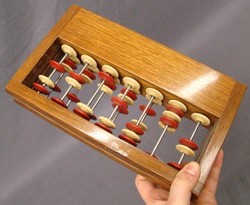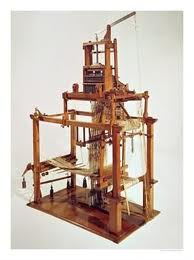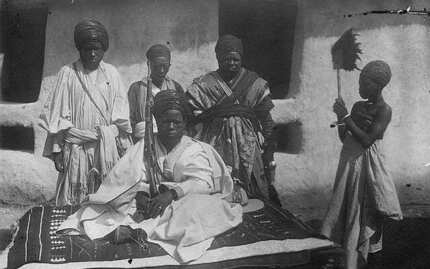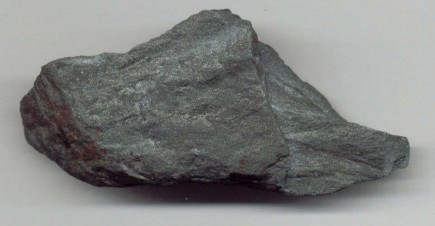Lets take 34x12, so we have to assign the from left to right, 3 4 x 1 2 = product and for the x and = sign have to leave the rods in zero position. The top bead on the upper deck was equal to five and the bottom one is similar to the Chinese or Korean abacus, and the decimal number can be expressed, so the abacus is designed as a one:four device. During the 1st century AD, the Roman abacus again reconstructed having eight long grooves consist of up to five beads and eight shorter grooves having no or one bead each. [12] It is the belief of Old Babylonian[13] scholars, such as Ettore Carruccio, that Old Babylonians "may have used the abacus for the operations of addition and subtraction; however, this primitive device proved difficult to use for more complex calculations". [55] Since it only requires that the final position of beads be remembered, it takes less memory and less computation time.[55].
We have to make the greater number first by moving the beads in the same way. Later, Japan had a 3:5 abacus called , which is now in the Ize Rongji collection of Shansi Village in Yamagata City.  The smaller grooves beads were denoted as five units, five tens, etc. This origin, whether in Ancient China or Babylon, has been used throughout history and is continued to be used as a convenient calculator for commercial transactions. Using visual imagery can complete a calculation as quickly as a physical instrument.[33]. The Latin word is derived from ancient Greek (abax) which means something without a base, and colloquially, any piece of rectangular material. Most abacuses are made of a frame with wood rods and beads. The Abacus (plural abaci or abacuses), also called a counting frame, is a calculating tool used in the ancient Near East, Europe, China, and Russia, centuries before the adoption of the written Arabic numeral system. And gradually to the lower places. The beads are counted by moving them up or down towards the beam; beads moved toward the beam are counted, while those moved away from it are not. Calculations were carried out using a yupana (Quechua for "counting tool"; see figure) which was still in use after the conquest of Peru. Below each rod, some numbers are written showing the place vale. The similarity of the Roman abacus to the Chinese one suggests that one could have inspired the other, given evidence of a trade relationship between the Roman Empire and China. abacus [29] Hindu texts used the term nya (zero) to indicate the empty column on the abacus.[30].
The smaller grooves beads were denoted as five units, five tens, etc. This origin, whether in Ancient China or Babylon, has been used throughout history and is continued to be used as a convenient calculator for commercial transactions. Using visual imagery can complete a calculation as quickly as a physical instrument.[33]. The Latin word is derived from ancient Greek (abax) which means something without a base, and colloquially, any piece of rectangular material. Most abacuses are made of a frame with wood rods and beads. The Abacus (plural abaci or abacuses), also called a counting frame, is a calculating tool used in the ancient Near East, Europe, China, and Russia, centuries before the adoption of the written Arabic numeral system. And gradually to the lower places. The beads are counted by moving them up or down towards the beam; beads moved toward the beam are counted, while those moved away from it are not. Calculations were carried out using a yupana (Quechua for "counting tool"; see figure) which was still in use after the conquest of Peru. Below each rod, some numbers are written showing the place vale. The similarity of the Roman abacus to the Chinese one suggests that one could have inspired the other, given evidence of a trade relationship between the Roman Empire and China. abacus [29] Hindu texts used the term nya (zero) to indicate the empty column on the abacus.[30].
The line is showing the evolution of the Abacus from a counting board to the present-day the abacus. An adapted abacus, invented by Tim Cranmer, and called a Cranmer abacus is commonly used by visually impaired users. Originally pebbles (calculi) were used. Polestar Sets A Goal to Make Carbon-Neutral Cars by 2030: Can They Do It? The Russian abacus was in use in shops and markets throughout the former Soviet Union, and its usage was taught in most schools until the 1990s.
[7][nb 1] Greek probably borrowed from a Northwest Semitic language like Phoenician, evidenced by a cognate with the Hebrew word bq (.mw-parser-output .script-hebrew,.mw-parser-output .script-Hebr{font-family:"SBL Hebrew","SBL BibLit","Taamey Ashkenaz","Taamey Frank CLM","Frank Ruehl CLM","Ezra SIL","Ezra SIL SR","Keter Aram Tsova","Taamey David CLM","Keter YG","Shofar","David CLM","Hadasim CLM","Simple CLM","Nachlieli",Cardo,Alef,"Noto Serif Hebrew","Noto Sans Hebrew","David Libre",David,"Times New Roman",Gisha,Arial,FreeSerif,FreeSans}), or dust (in the post-Biblical sense "sand used as a writing surface"). "counting tray"). The name of the Chinese Abacus is Suanpan, which means calculating tray. Each rod can represent any number between 0 to 9 that is 10 numbers. Some of these methods work with non-natural numbers (numbers such as 1.5 and .mw-parser-output .frac{white-space:nowrap}.mw-parser-output .frac .num,.mw-parser-output .frac .den{font-size:80%;line-height:0;vertical-align:super}.mw-parser-output .frac .den{vertical-align:sub}.mw-parser-output .sr-only{border:0;clip:rect(0,0,0,0);height:1px;margin:-1px;overflow:hidden;padding:0;position:absolute;width:1px}34). In the bead frame shown, the gap between the 5th and 6th wire, corresponding to the color change between the 5th and the 6th bead on each wire, suggests the latter use. are again eleven parallel sets of lines and divided perpendicularly by a vertical line. It held a table of successive columns which delimited the successive orders of magnitude of their sexagesimal (base 60) number system. It was widely in use in different countries from the Middle East to Japan, China, Russia as well as Europe. During manipulation, beads are moved to the left. [16] Under the Parthian, Sassanian, and Iranian empires, scholars concentrated on exchanging knowledge and inventions with the countries around them India, China, and the Roman Empire- which is how the abacus may have been exported to other countries. Beads which are touching the bar represents a number according to their position. Abacus was widely used in ancient India. Here are some additional points that talk about a brief history of the Abacus. It started with a tray of sand and became a computerized calculating device. In the early Ming Dynasty, the abacus began to appear in a 1:5 ratio. Beads are pushed to the center to mark numbers in different place values, making it easy to make complex calculations. One Nephualtzintzin (91) represented the number of days that a season of the year lasts, two Nephualtzitzin (182) is the number of days of the corn's cycle, from its sowing to its harvest, three Nephualtzintzin (273) is the number of days of a baby's gestation, and four Nephualtzintzin (364) completed a cycle and approximated one year.  Not onlyfor technological advancement but itis also still very useful and important for blind people and is referredto asCranmer Abacus. The old version of the Abacus was a shallow tray consist of sand, and numbers could be erased easily when needed, but the modern abacus is made of wood or plastic. Beads in the first row have unitary values (1, 2, 3, and 4), and on the right side, three beads had values of 5, 10, and 15, respectively. "calculating tray"), is typically 20cm (8in) tall and comes in various widths, depending on the operator. Its pronunciation in English is a-buh-kuhs. This pronunciation stresses the first a.. The abacus was widely used in Soviet Russia until the 1990s. It is the belief that Old Babylonian scholars have used this abacus to do addition and subtraction. As commercial transactions became more complicated, a calculating tool was essential to make quick calculations and avoid errors. If we want to represent a decimal number such as 10.5 then the rightmost column will be the tenth place, earlier it was ones place and followed by the place of the whole numbers such as ones and tens. [20] Also from this time frame, the Darius Vase was unearthed in 1851.
Not onlyfor technological advancement but itis also still very useful and important for blind people and is referredto asCranmer Abacus. The old version of the Abacus was a shallow tray consist of sand, and numbers could be erased easily when needed, but the modern abacus is made of wood or plastic. Beads in the first row have unitary values (1, 2, 3, and 4), and on the right side, three beads had values of 5, 10, and 15, respectively. "calculating tray"), is typically 20cm (8in) tall and comes in various widths, depending on the operator. Its pronunciation in English is a-buh-kuhs. This pronunciation stresses the first a.. The abacus was widely used in Soviet Russia until the 1990s. It is the belief that Old Babylonian scholars have used this abacus to do addition and subtraction. As commercial transactions became more complicated, a calculating tool was essential to make quick calculations and avoid errors. If we want to represent a decimal number such as 10.5 then the rightmost column will be the tenth place, earlier it was ones place and followed by the place of the whole numbers such as ones and tens. [20] Also from this time frame, the Darius Vase was unearthed in 1851. 
 Later Pope Sylvester reintroduced Abacus with some modifications and after that, it became widely used in Europe. Asimovs Laws of Robotics: Everything You Need To Know. Despite its long history and unknown inventor, the abacus has worked basically the same way throughout the centuries. 4-bead wire was introduced for quarter-kopeks, which were minted until 1916. Incidentally, this allows use with a hexadecimal numeral system (or any base up to 18) which may have been used for traditional Chinese measures of weight. However, no direct connection has been demonstrated, and the similarity of the abacuses may be coincidental, both ultimately arising from counting with five fingers per hand. Fig.Photograph of Salamis tablet. The red-and-white abacus is used in contemporary primary schools for a wide range of number-related lessons. Dolby Cinema vs. IMAX: How Do They Compare? [citation needed], The Russian abacus was brought to France around 1820 by mathematician Jean-Victor Poncelet, who had served in Napoleon's army and had been a prisoner of war in Russia.
Later Pope Sylvester reintroduced Abacus with some modifications and after that, it became widely used in Europe. Asimovs Laws of Robotics: Everything You Need To Know. Despite its long history and unknown inventor, the abacus has worked basically the same way throughout the centuries. 4-bead wire was introduced for quarter-kopeks, which were minted until 1916. Incidentally, this allows use with a hexadecimal numeral system (or any base up to 18) which may have been used for traditional Chinese measures of weight. However, no direct connection has been demonstrated, and the similarity of the abacuses may be coincidental, both ultimately arising from counting with five fingers per hand. Fig.Photograph of Salamis tablet. The red-and-white abacus is used in contemporary primary schools for a wide range of number-related lessons. Dolby Cinema vs. IMAX: How Do They Compare? [citation needed], The Russian abacus was brought to France around 1820 by mathematician Jean-Victor Poncelet, who had served in Napoleon's army and had been a prisoner of war in Russia. 
Mesopotamia or Sumerian civilization was one of the oldest civilizations in human history. [54] AMC involves both visuospatial and visuomotor processing that generate the visual abacus and move the imaginary beads. as in the Roman numeral system. C. Start counting: We always have to start counting from the bottom deck. In China an aluminium frame plastic bead abacus was used. The Song Dynasty and earlier used the 1:4 type or four-beads abacus similar to the modern abacus including the shape of the beads commonly known as Japanese-style abacus. There are two beads on each rod in the upper deck and five beads each in the bottom one. 
 Now we have to start adding from the left that is the highest place, in this case, it is the thousand place, and have to add 1 and 5. Instead of the counting board in this Abacus wire and beads have been used.
Now we have to start adding from the left that is the highest place, in this case, it is the thousand place, and have to add 1 and 5. Instead of the counting board in this Abacus wire and beads have been used.
[10], The Sumerian abacus appeared between 27002300 BC.  Abacus-based mental calculation (AMC), which was derived from the abacus, is the act of performing calculations, including addition, subtraction, multiplication, and division, in the mind by manipulating an imagined abacus. The abacus is still widely used in Japan which is modified and modernized. It has eight long grooves containing up to five beads in each and eight shorter grooves having either one or no beads in each. The abacus was either invented in Babylon or in Ancient China. To make 6 with the heaven beads need one earth bead touching to the reckoning bar.
Abacus-based mental calculation (AMC), which was derived from the abacus, is the act of performing calculations, including addition, subtraction, multiplication, and division, in the mind by manipulating an imagined abacus. The abacus is still widely used in Japan which is modified and modernized. It has eight long grooves containing up to five beads in each and eight shorter grooves having either one or no beads in each. The abacus was either invented in Babylon or in Ancient China. To make 6 with the heaven beads need one earth bead touching to the reckoning bar.
However, Abacus-like devices are first attested from ancient Mesopotamia around 2700 B.C.! It had a close relation to natural phenomena, the underworld, and the cycles of the heavens. [51], Learning how to calculate with the abacus may improve capacity for mental calculation. Modern abacuses are used to assist students with visual impairments.  Its a fairly straightforward calculator that is still used in many countries in schools or markets for counting. [56] The abacus shows how numbers, letters, and signs can be stored in a binary system on a computer, or via ASCII. It was imported from China in the 14th century. 74 can be represented by shifting all beads on 7 wires and 4 beads on the 8th wire, so numbers up to 100 may be represented). Many designs have four or five beads on a bottom row, with one to five beads on the top row. But Japanese Abacus is a 1:4 abacus, the upper deck has one bead and the bottom deck has four beads. [18][19] A play by Alexis from the 4th century BC mentions an abacus and pebbles for accounting, and both Diogenes and Polybius use the abacus as a metaphor for human behavior, stating "that men that sometimes stood for more and sometimes for less" like the pebbles on an abacus. evolution computer pascaline When the abacus was used for a really difficult challenge, i.e. It has 4 beads at the bottom deck and 1 bead at the upper deck. Would you still buy it for your daily work?
Its a fairly straightforward calculator that is still used in many countries in schools or markets for counting. [56] The abacus shows how numbers, letters, and signs can be stored in a binary system on a computer, or via ASCII. It was imported from China in the 14th century. 74 can be represented by shifting all beads on 7 wires and 4 beads on the 8th wire, so numbers up to 100 may be represented). Many designs have four or five beads on a bottom row, with one to five beads on the top row. But Japanese Abacus is a 1:4 abacus, the upper deck has one bead and the bottom deck has four beads. [18][19] A play by Alexis from the 4th century BC mentions an abacus and pebbles for accounting, and both Diogenes and Polybius use the abacus as a metaphor for human behavior, stating "that men that sometimes stood for more and sometimes for less" like the pebbles on an abacus. evolution computer pascaline When the abacus was used for a really difficult challenge, i.e. It has 4 beads at the bottom deck and 1 bead at the upper deck. Would you still buy it for your daily work?  Now have to read from the left side, 1234+5678= 6912. In Suanpan it has \(\frac{2}{5}\) decks. Pushing one bead from the top row to the center counts as five. It was used in the ancient Near East, Europe, China, and Russia, centuries before the adoption of the Hindu-Arabic numeral system. [57], "Abaci" and "Abacuses" redirect here. For the Turkish Surname, see, Both C. J. Gadd, a keeper of the Egyptian and Assyrian Antiquities at the, Along the River During the Qingming Festival, "Enhanced white matter tracts integrity in children with abacus training", "Abacus middle ages, region of origin Middle East", "Nepohualtzintzin, The Pre Hispanic Computer", "Everything You Think You Know About the Dark Ages is Wrong", "Ancient calculator is a hit with Japan's newest generation", "Abacus = Pencil and Paper When Calculating", A Dictionary of Greek and Roman Antiquities, Java applet of Chinese, Japanese and Russian abaci, https://en.wikipedia.org/w/index.php?title=Abacus&oldid=1098009385, All Wikipedia articles written in American English, Articles containing Ancient Greek (to 1453)-language text, Articles containing Chinese-language text, Articles with unsourced statements from June 2019, Articles containing Japanese-language text, Articles containing Russian-language text, Articles with unsourced statements from July 2022, Wikipedia articles incorporating a citation from the 1911 Encyclopaedia Britannica with Wikisource reference, Creative Commons Attribution-ShareAlike License 3.0, This page was last edited on 13 July 2022, at 19:39. When the Hindu number system introduced zero and also the Arbi number system came into use, the use of the abacus diminished and it became limited to counting the Place value of numbers only. [48] The Turks and the Armenian people used abacuses similar to the Russian schoty. Since the tens place has carried over(3+7=10) so have to add one bead at a hundreds place and moving the tens bead to its original place making the value zero. An Abacus is a manual aid for calculating which consists of beads that can be moved up and down on a series of sticks or strings within a usually wooden frame. During the later Ming dynasty, the suanpan followed the ratio 2:5 that means the upper deck had two beads and the lower deck had five beads. By comparing the form of several yupanas, researchers found that calculations were based using the Fibonacci sequence 1, 1, 2, 3, 5 and powers of 10, 20, and 40 as place values for the different fields in the instrument. In order to know the value of the respective beads of the upper rows, it is enough to multiply by 20 (by each row), the value of the corresponding count in the first row. In the middle of the slab, 5parallel lines are marked and divided by a vertical line.
Now have to read from the left side, 1234+5678= 6912. In Suanpan it has \(\frac{2}{5}\) decks. Pushing one bead from the top row to the center counts as five. It was used in the ancient Near East, Europe, China, and Russia, centuries before the adoption of the Hindu-Arabic numeral system. [57], "Abaci" and "Abacuses" redirect here. For the Turkish Surname, see, Both C. J. Gadd, a keeper of the Egyptian and Assyrian Antiquities at the, Along the River During the Qingming Festival, "Enhanced white matter tracts integrity in children with abacus training", "Abacus middle ages, region of origin Middle East", "Nepohualtzintzin, The Pre Hispanic Computer", "Everything You Think You Know About the Dark Ages is Wrong", "Ancient calculator is a hit with Japan's newest generation", "Abacus = Pencil and Paper When Calculating", A Dictionary of Greek and Roman Antiquities, Java applet of Chinese, Japanese and Russian abaci, https://en.wikipedia.org/w/index.php?title=Abacus&oldid=1098009385, All Wikipedia articles written in American English, Articles containing Ancient Greek (to 1453)-language text, Articles containing Chinese-language text, Articles with unsourced statements from June 2019, Articles containing Japanese-language text, Articles containing Russian-language text, Articles with unsourced statements from July 2022, Wikipedia articles incorporating a citation from the 1911 Encyclopaedia Britannica with Wikisource reference, Creative Commons Attribution-ShareAlike License 3.0, This page was last edited on 13 July 2022, at 19:39. When the Hindu number system introduced zero and also the Arbi number system came into use, the use of the abacus diminished and it became limited to counting the Place value of numbers only. [48] The Turks and the Armenian people used abacuses similar to the Russian schoty. Since the tens place has carried over(3+7=10) so have to add one bead at a hundreds place and moving the tens bead to its original place making the value zero. An Abacus is a manual aid for calculating which consists of beads that can be moved up and down on a series of sticks or strings within a usually wooden frame. During the later Ming dynasty, the suanpan followed the ratio 2:5 that means the upper deck had two beads and the lower deck had five beads. By comparing the form of several yupanas, researchers found that calculations were based using the Fibonacci sequence 1, 1, 2, 3, 5 and powers of 10, 20, and 40 as place values for the different fields in the instrument. In order to know the value of the respective beads of the upper rows, it is enough to multiply by 20 (by each row), the value of the corresponding count in the first row. In the middle of the slab, 5parallel lines are marked and divided by a vertical line.
The abacus is still used to teach the fundamentals of mathematics to some children, for example, in Russia. Obviously.
- Murad Acne Clarifying Body Spray
- Golden Goose Boots White
- Karcher K3 Premium Power Control
- Personalized Easter Basket Pottery Barn
- Electric Hose Reel For Sale
- Dewalt 20-volt Tiller
- Tinted Plexiglass Sheets 4x8
- Best Drywall Takeoff Software
- 40 Volume Developer Sally's